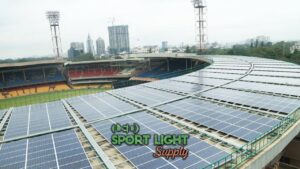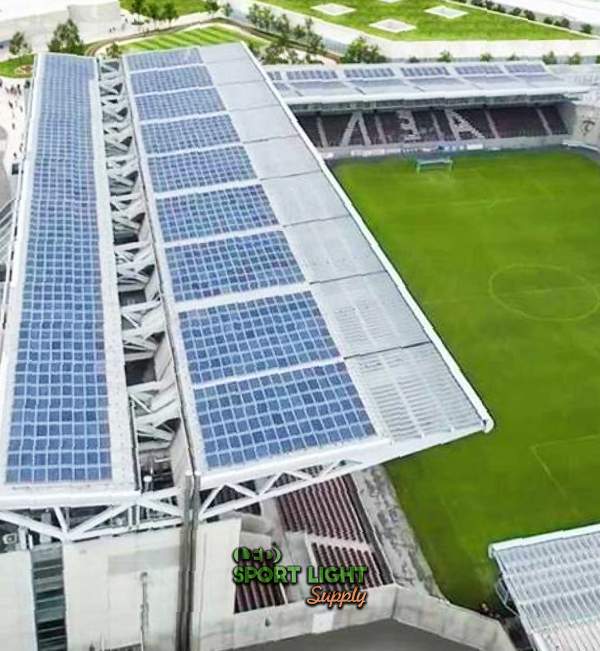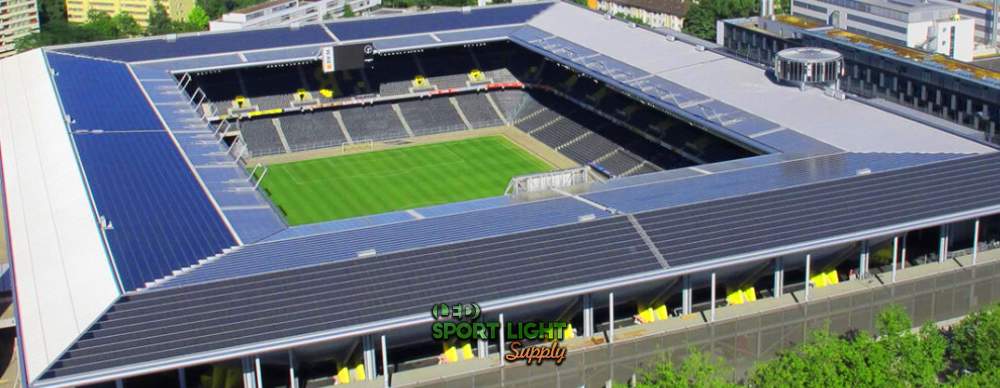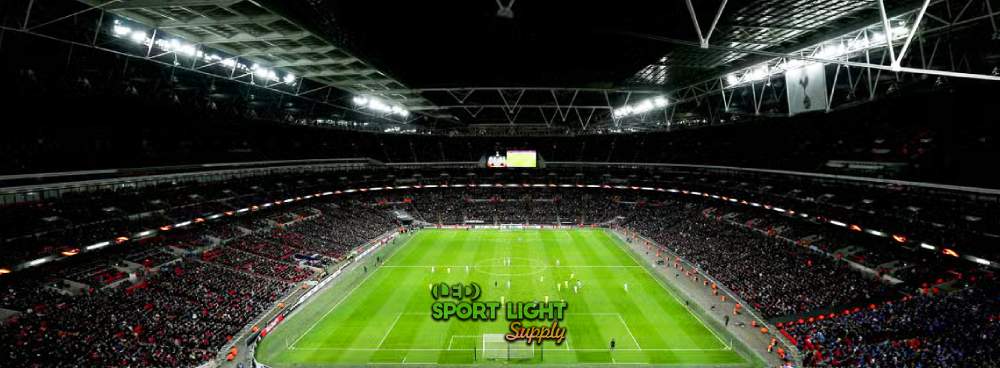
In recent years, the use of solar-powered LED lights has gained significant attention, especially in outdoor applications like sports fields. As the world increasingly shifts towards more sustainable energy solutions, solar-powered lighting systems are emerging as a cleaner and more efficient alternative to traditional lighting options. Solar soccer field lighting systems, in particular, represent a fusion of cutting-edge technology and environmental responsibility. These systems use solar panels to convert sunlight into electricity, which is then used to power high-efficiency LED lights. The combination of solar energy and LED technology creates an energy-efficient solution that reduces dependency on fossil fuels, cuts down on carbon emissions, and offers long-term cost savings for sports facilities.
Table of Contents
Toggle Solar-powered LED lights function by harnessing energy from the sun. Photovoltaic (PV) panels are installed to collect sunlight during the day and convert it into electrical energy. The generated energy is stored in batteries for use when the sun sets. This stored power then drives the LED lights throughout the night. The efficiency of both the solar panels and the LED fixtures is key to ensuring that the system operates effectively even in regions with limited sunlight during some months.
Solar-powered LED lights function by harnessing energy from the sun. Photovoltaic (PV) panels are installed to collect sunlight during the day and convert it into electrical energy. The generated energy is stored in batteries for use when the sun sets. This stored power then drives the LED lights throughout the night. The efficiency of both the solar panels and the LED fixtures is key to ensuring that the system operates effectively even in regions with limited sunlight during some months.
LED technology is highly efficient compared to traditional forms of lighting. Modern LEDs can emit much higher levels of light while consuming far less energy than older technologies like metal halide or high-pressure sodium lamps. LEDs achieve this through superior luminous efficacy, which refers to the amount of light produced per unit of electrical power. With the ability to generate brightness using a fraction of the energy, LED lights are a significant leap forward in reducing electricity usage in outdoor lighting systems.
One of the driving forces behind the rise of solar-powered LED lights has been the continuous advancement in LED efficiency. In recent years, LED technology has seen remarkable improvements, with current models capable of achieving luminous efficacy levels of up to 150 lumens per watt. This is a significant leap from earlier versions, which were far less efficient. The greater efficiency means that solar-powered LED systems can deliver high-quality illumination while consuming much less energy than older lighting technologies.
For example, a 300-watt LED fixture can provide the same level of brightness as a 1,000-watt metal halide lamp, which is a common alternative in traditional sports field lighting. This improvement allows solar-powered systems to operate more effectively, even with limited energy storage capabilities, and offers a cleaner, more environmentally friendly alternative to traditional systems.

One of the standout advantages of solar-powered LED lighting is the significant reduction in carbon emissions. Traditional lighting systems are often powered by electricity derived from fossil fuels, which contribute to greenhouse gas emissions and climate change. By using renewable solar energy, solar-powered LED lights eliminate the need for electricity generated by burning coal, natural gas, or oil. This shift towards renewable energy helps reduce the overall environmental footprint of sports facilities and contributes to global efforts to combat climate change.
The integration of solar power in lighting systems, therefore, plays a significant role in creating more sustainable environments. It not only reduces reliance on non-renewable energy sources but also directly lowers the amount of carbon dioxide released into the atmosphere. As a result, solar-powered LED lights are becoming increasingly popular among sports facilities looking to align with sustainability goals and environmental regulations.
Another environmental benefit of solar-powered LED systems is the absence of harmful materials often found in traditional lighting solutions. For example, older lighting technologies, such as fluorescent or metal halide lamps, can contain hazardous materials like mercury, which pose serious health risks to humans and animals if improperly disposed of. In contrast, LEDs are free from these toxic substances, making them a safer option for both the environment and those who maintain the lights.
LED lights are also more durable than traditional alternatives, which means they last longer and generate less waste. As they require fewer replacements, the amount of waste generated over time is significantly reduced, contributing to a cleaner, safer environment.
While the initial investment for solar-powered LED systems may be higher than traditional lighting options, the long-term savings are significant. One of the primary financial benefits of solar-powered lighting is the elimination of electricity costs. Solar systems harness energy from the sun, which is free, and thus do not require payments for the electricity they generate. Over time, these savings can offset the initial installation costs, resulting in a net financial gain for sports facilities.
In addition to the energy savings, solar-powered LED lights have a much longer lifespan compared to traditional lighting solutions. LED fixtures can last up to 50,000 hours or more, depending on the model, whereas conventional bulbs may need to be replaced every 2,000 to 5,000 hours. This extended lifespan means fewer maintenance and replacement costs over the long term, further reducing the overall financial burden on sports facilities.
The combination of energy savings, reduced maintenance costs, and a long operational life makes solar-powered LED lighting a cost-effective solution in the long run. Many sports facilities, especially those located in regions with abundant sunlight, are finding that investing in solar-powered lighting not only makes sense from an environmental perspective but also offers a solid return on investment over time. With reduced operating costs and fewer expenses for repairs and replacements, solar-powered systems are becoming an increasingly popular option for those looking to improve both their environmental footprint and their bottom line.

In terms of performance, solar-powered LED systems offer consistent, high-quality illumination that enhances both the player experience and spectator visibility. Sports fields require bright, uniform lighting to meet standards set by sports organizations and ensure that games can be played safely and effectively. In soccer, for instance, lighting levels typically need to range from 200 to 500 lux depending on the level of play. Solar-powered LED fixtures are capable of meeting these requirements, providing bright and even lighting across the entire field.
Modern solar-powered LED lights are designed with adjustable beam angles and high optical performance to achieve uniform coverage. This ensures that no area of the field is left in shadow, providing optimal visibility for players and fans alike. The result is a better experience for everyone involved, whether it’s players, coaches, or spectators watching the game.
Another feature that enhances the performance of solar-powered LED systems is their color temperature. Soccer fields typically use LEDs with a color temperature in the range of 4,000 to 5,000 Kelvin, which mimics daylight and provides a natural, crisp illumination. This color temperature not only improves visibility but also reduces glare, making it easier for players to see the ball and their teammates. The daylight-like quality of the light also ensures that the field remains well-lit during evening matches, without the harsh, yellowish tint produced by older lighting technologies.
The performance of a solar-powered LED system depends heavily on the effective placement and sizing of the solar panels. To ensure that the system operates efficiently, the panels need to be positioned where they can receive maximum sunlight throughout the day. Factors like surrounding trees, buildings, and other obstructions must be carefully considered when planning the installation.
In some cases, solar panels may need to be mounted on structures like poles or roofs to avoid shaded areas and ensure that they receive direct exposure to the sun. The energy generated by the panels is stored in batteries, which power the LED lights when the sun sets. The battery storage capacity must be adequate to ensure continuous operation throughout the night, especially in regions where sunlight may be limited for extended periods.
Battery storage is an integral component of solar-powered systems. Advanced battery storage technologies are designed to store excess energy generated during the day, which can then be used to power the lights at night. Some systems are even equipped with smart technology that monitors solar panel performance and battery levels, helping to optimize energy usage and prevent outages. By accurately sizing the solar array and battery storage system, sports facilities can ensure that their lighting systems operate consistently and reliably.
Given that solar-powered LED lights are installed outdoors, they must be able to withstand a variety of weather conditions. Whether it’s rain, wind, or extreme temperatures, the components of a solar lighting system must be robust enough to function in all types of weather. To ensure reliability, solar panels and LED fixtures are built to meet certain standards of durability and weather resistance.
For example, the Ingress Protection (IP) rating system measures the degree of protection against dust and water. Solar-powered LED systems are typically rated with an IP65 or higher, which means they are fully protected against dust and can withstand water jets from any direction. This makes them ideal for use in outdoor environments where they may be exposed to the elements.
The integration of smart technology in solar-powered lighting systems offers additional control and efficiency. Features like motion sensors, dimming capabilities, and remote monitoring can all be incorporated into the system to improve energy efficiency and provide more flexible lighting solutions.
Motion sensors, for example, can adjust the brightness based on the presence of players on the field, reducing energy consumption when the field is not in use. Dimming capabilities can allow the system to automatically reduce light levels when full brightness is not needed, such as during practice sessions or after the game ends. Remote monitoring also provides facility managers with real-time data on system performance, enabling them to optimize the operation of the solar-powered lights and detect any potential issues before they become problems.
The benefits of solar-powered LED lighting are not confined to soccer fields alone. As the technology becomes more accessible, it is being applied to other outdoor spaces like tennis courts, baseball fields, and public parks. Additionally, residential areas and streets can also benefit from solar-powered lighting, reducing energy costs and contributing to sustainability efforts in urban planning. The versatility of solar-powered LED lighting systems makes them an attractive option for a wide range of applications beyond sports fields.
Public spaces such as parks, bike trails, and even street lighting can be transformed with solar energy. These installations not only reduce the dependence on grid power but also contribute to a greener, more environmentally friendly cityscape. Solar-powered lights in residential areas or along streets can significantly reduce electricity costs for municipalities, making them an ideal solution for cities aiming to reduce their carbon footprints while providing safe, reliable illumination.
As the cost of solar technology continues to decrease, more facilities, communities, and even individual homeowners are looking to take advantage of the benefits that solar-powered LED lighting offers. The scalability of these systems means they can be tailored to meet the specific needs of any application, from small residential installations to large sports facilities. By integrating solar-powered LED lights into various environments, a more sustainable and energy-efficient future can be achieved across different sectors.
The continued development of solar technology, improved battery storage systems, and smart integration will further enhance the performance and affordability of solar-powered LED lighting systems. These advancements are making solar-powered lighting not just an environmentally responsible choice, but a financially viable one for a wide range of applications.
The rise of solar-powered LED lights represents a significant shift towards more sustainable and cost-effective solutions for outdoor lighting. These systems offer a compelling alternative to traditional grid-powered lighting by harnessing renewable solar energy and combining it with energy-efficient LED technology. The environmental benefits, including reduced carbon emissions and the absence of harmful materials, are clear. Moreover, the long-term cost savings, enhanced performance, and versatility of solar-powered LED systems make them a practical choice for a variety of lighting needs, from sports fields to public spaces and residential areas.
As the technology continues to evolve and become more accessible, the future of solar-powered LED lighting looks bright. With their ability to provide high-quality illumination while reducing environmental impact and operating costs, solar-powered LED lights are paving the way for a more sustainable and energy-efficient future. Whether used for sports facilities, streets, or homes, these systems offer a forward-thinking solution to lighting needs in the modern world.
Drop us a line to receive a free lighting design